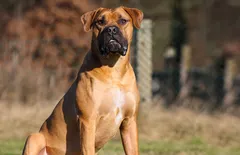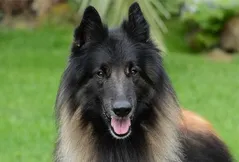
Boerboel
The Boerboel is strong and confident in appearance with powerful, free-flowing movement. They are calm, highly intelligent, and incredibly loyal.
Overall Status
| Height | 22 to 27 inches |
| Temperament | Confident, Intelligent, Calm |
| Weight | 150 to 200 pounds |
| Life Expectancy | 9 to 11 years |
| Coat Color | Brindle, Black, Piebald, Fawn |
| Barking Level | When Necessery |
Quick Factors
| Playfulness | |
| Dog Friendly | |
| Exercise Need | |
| Grooming Needs | |
| Strangers Friendly | |
| Family Affectionate |
Daily Care
Grooming Tips
The Boerboel has a short, bristly coat that is easy to care for. Brush him weekly with a rubber curry brush to remove dead hair (and help keep it off your clothing and furniture).Bathe himas needed using a mild,pet-safe shampoo.The rest is basic care.Trim the nailsevery week or two, andbrush his teethoften — with a vet-approved pet toothpaste — for good overall health and fresh breath.
Exercise Tips
The strong, athletic Boerboel needs dailyexercise, such as long walks on a leash or play sessions in a securely fenced area with his owner. Boerboels need mental stimulation and interaction with their owners along with the physical activity.They will not take kindly to challenges from other dogs, and visiting dog parks are not recommended. Because of their protective instinct, the Boerboel should never be allowed off leash. The breed often enjoys participating inobedience,rally, weight pull, andagilitycompetitions, as well as protection sports and stock work.
Feeding Tips
TheBoerboel should do well on high-quality dog food, whether commercially manufactured or home-prepared with your veterinarian’s supervision and approval.Any diet should be appropriate to the dog’s age (puppy, adult, or senior). Some dogs are prone to gettingoverweight, so watch your dog’s calorie consumption and weight level.Treatscan be an important aid in training, but giving too many can cause obesity. Learn about whichhuman foodsare safe for dogs, and which are not. Check with your vet if you have any concerns about your dog’s weight or diet.Clean, fresh water should be available at all times.
Health Tips
Although generally a healthy breed, the Boerboel is prone to hip and elbow dysplasia. This is quite common in very large breeds of dogs. Eye problems such as Entropion and Ectropion have also been found in the breed.To minimize the potential of genetic health issues, don’t buy your Boerboel puppy from puppy stores or dubious backyard breeders. Puppy mills produce sick puppies that are often born with defects or that develop breed-specific issues later in life. When you buy from a reputable breeder, you will get a health guarantee and know there’s less risk for problems to appear.The Boerboel is predisposed to gastric dilation and volvulus, commonly referred to as bloat. Limiting exercise for an hour after meals can help to lessen the chance of this life-threatening problem.
Trainability
Firm and consistent training are necessary for the breed to coexist successfully with human families. This is a bright breed that is strong-willed and will do all things possible to become the Alpha dog in the pack. This can never be allowed to happen.The Boerboel must have an assertive owner who will ensure that the dog has daily training sessions, even if they are continuously going over the same commands. Every member of the family must continuously be seen as above the Boerboel, in the dog’s mind. Training can help do this.All training should be done using positive methods and a treat based reward system. Harshness or manhandling the Boerboel will only lead to resentment and aggression. This dog wants to be the Alpha dog in the pack. Your family is his pack. A dominant and solid pecking order must be established and maintained in order to have a peaceful and pleasant existence with the Boerboel.
History
When Dutch farmers went to South Africa, they took dogs with them. One of those farmers was Jan van Riebeeck, who brought a type of dog called abullenbijterorbullenbeisser, which translates roughly to bull biter. This nameless Mastiff-typedog, along with indigenous African dogs, was one of the ancestors of the Boerboel. The farmers needed tough dogs they thought could withstand the hot climate and harsh surroundings and stand up to predators such as hyenas, bigcatsand baboons.The Boers, as the farmers were known, created a dog who would be loyal, obedient and protective. Later, when diamond mining became an important industry, the dogs were bred withBullmastiffs, who had been brought in to guard the mines.Rhodesian Ridgebacksalso contributed to the Boerboel’s development.In the 1980s, South African dog lovers set out to establish a standard for the breed. They selected 72 dogs that met their criteria. Today, the Boerboel is still considered a rare breed throughout the world.The American Kennel Club classifies the Boerboel as a working dog and granted it full recognition in January 2015, paving the way for the breed’s participation in conformation showing and other AKC events.






